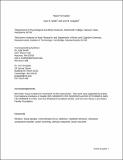| dc.contributor.author | Smith, Kyle S. | |
| dc.contributor.author | Graybiel, Ann M | |
| dc.date.accessioned | 2017-01-31T18:19:38Z | |
| dc.date.available | 2017-01-31T18:19:38Z | |
| dc.date.issued | 2016-03 | |
| dc.identifier.issn | 1958-5969 | |
| dc.identifier.uri | http://hdl.handle.net/1721.1/106812 | |
| dc.description.abstract | Habits, both good ones and bad ones, are pervasive in animal behavior. Important frameworks have been developed to understand habits through psychological and neurobiological studies. This work has given us a rich understanding of brain networks that promote habits, and has also helped us to understand what constitutes a habitual behavior as opposed to a behavior that is more flexible and prospective. Mounting evidence from studies using neural recording methods suggests that habit formation is not a simple process. We review this evidence and take the position that habits could be sculpted from multiple dissociable changes in neural activity. These changes occur across multiple brain regions and even within single brain regions. This strategy of classifying components of a habit based on different brain signals provides a potentially useful new way to conceive of disorders that involve overly fixed behaviors as arising from different potential dysfunctions within the brain's habit network. | en_US |
| dc.description.sponsorship | National Institutes of Health (U.S.) (NIH Grant R01 MH060379) | en_US |
| dc.description.sponsorship | National Institutes of Health (U.S.) (NIH Grant R01 NS025529) | en_US |
| dc.description.sponsorship | National Institutes of Health (U.S.) (NIH Grant R01 EY012848) | en_US |
| dc.description.sponsorship | National Institutes of Health (U.S.) (NIH Grant F32 MH08545) | en_US |
| dc.description.sponsorship | Whitehall Foundation | en_US |
| dc.description.sponsorship | Nancy Lurie Marks Family Foundation | en_US |
| dc.language.iso | en_US | |
| dc.publisher | AICH - Servier Research Group | en_US |
| dc.relation.isversionof | http://www.dialogues-cns.org/publication/habit-formation/ | en_US |
| dc.rights | Creative Commons Attribution-Noncommercial-Share Alike | en_US |
| dc.rights.uri | http://creativecommons.org/licenses/by-nc-sa/4.0/ | en_US |
| dc.source | Prof. Graybiel via Courtney Crummett | en_US |
| dc.title | Habit formation | en_US |
| dc.type | Article | en_US |
| dc.identifier.citation | Smith, Kyle S., and Ann M. Graybiel. "Habit formation." Dialogues in Clinical Neuroscience 2016; 18 (1): 33-43. | en_US |
| dc.contributor.department | Massachusetts Institute of Technology. Department of Brain and Cognitive Sciences | en_US |
| dc.contributor.department | McGovern Institute for Brain Research at MIT | en_US |
| dc.contributor.approver | Graybiel, Ann M | en_US |
| dc.contributor.mitauthor | Graybiel, Ann M | |
| dc.relation.journal | Dialogues in Clinical Neuroscience | en_US |
| dc.eprint.version | Author's final manuscript | en_US |
| dc.type.uri | http://purl.org/eprint/type/JournalArticle | en_US |
| eprint.status | http://purl.org/eprint/status/PeerReviewed | en_US |
| dspace.orderedauthors | Smith, Kyle S.; Graybiel, Ann M. | en_US |
| dspace.embargo.terms | N | en_US |
| dc.identifier.orcid | https://orcid.org/0000-0002-4326-7720 | |
| mit.license | OPEN_ACCESS_POLICY | en_US |
